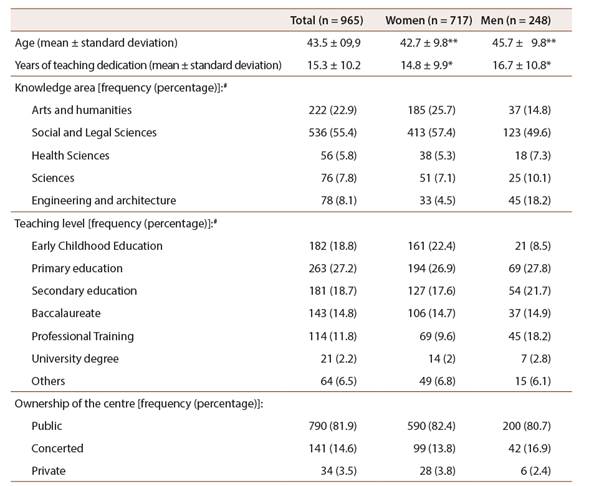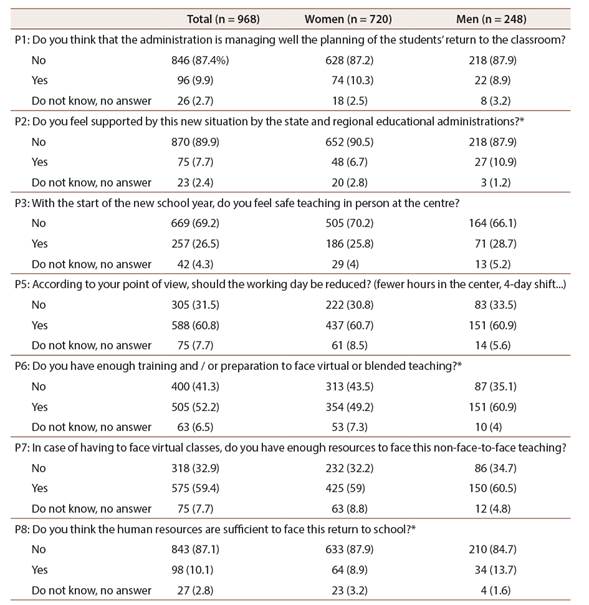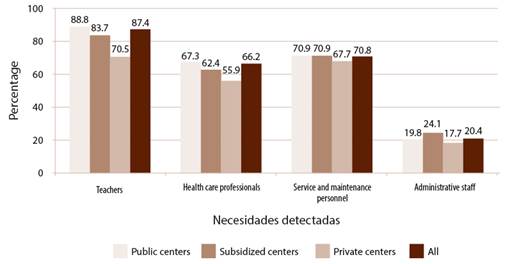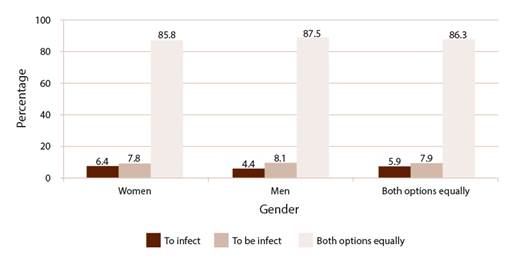Introduction
The spread of the new Coronavirus called SARS-Cov-2 caused educational institutions in Spain to close in March 2020 as a measure of health protection for students, workers and families (Gupta & Jawanda, 2020; World Health Organization, 2020). After the period of maximum restrictions, in September of the same year the return to the classroom was proposed with the beginning of the 2020-2021 academic year. However, this return occurred in a context of uncertainty about the new conditions imposed by the health situation (MacIntyre et al., 2020). In fact, Kim and Asbury (2020) have described insecurity and ignorance of what will happen as stressors for teachers. All this caused, fundamentally, by the teachers’ perception of the loss of control over work and the lack of support for the performance of teaching tasks (Trust & Whalen, 2020).
The general purpose of this article is to know how Spanish teachers faced the new academic year after going through the COVID-19 confinement period, and what their thoughts and concerns were about the resources offered by the administration and the way of carrying out the new course.
In the summer of 2020, in Spain it was still not known exactly what the planning of school activities for the following year would be like (Gandolfi, 2021). However, this health crisis can be interpreted as an experience from which to obtain learning that helps the educational community and, especially, in order to be prepared for a new similar situation (Aznar Sala, 2020). In other words, the situation experienced has represented a turning point for teachers at all educational levels (González-Calvo et al., 2020).
At the beginning of the 2020-2021 academic year, the different government, health and educational organizations had to face the implementation of protocols and action plans in school classrooms for the prevention of COVID-19. Protocols that, due to the autonomous administrative organization of Spain (Rodríguez-Nogueira et al., 2021), are different in each autonomous community (AC) (Varea et al., 2022). This new context directly influences the pedagogical decision-making processes by teachers and, consequently, the learning experience of students (Biesta, 2009; Lepp et al., 2021). For this reason, this research was carried out with the objective of analyzing the attitudes and needs perceived by Spanish teachers in the 2020-2021 academic year. All this with the previous hypotheses that the attitudes could be of concern or insecurity and that they did have additional needs in relation to the human resources available in the educational centers.
Material and Method
Design and sample
For this research, a cross-sectional descriptive study has been carried out in a representative sample of Spanish teachers. The National Institute of Statistics (Instituto Naciona de Estadística (INE), 2020) censused the population of Spanish teachers at 847,713. According to the INE data, estimating a sample heterogeneity of 50%, a confidence level of 99% and a margin of error of 5%, it would be necessary to reach a sample size of 663 teachers. However, for this work, a sample of 965 teachers of different educational levels from all the ACs of Spain has been obtained.
The questionnaires were completed virtually during the month of August 2020. An email with the protocol and instructions was sent to all practicing teachers in Spain through a database of emails from public, concerted and private educational centres in Spain. Thus, a sample of 965 teachers was obtained who indicated their agreement to participate in the study voluntarily and asked the different questions on the form sent by email. In the same way, in the questionnaire itself it was indicated to all participating teachers that the principles of the International Code of Ethics in Humanities and Social Sciences of the Center for Research Ethics & Bioethics (European Commission, 2021) and Law 15/1999 on the Protection of Data from Spain (Gobierno de España, Jefatura del Estado, 1999) were followed. In turn, the research protocol was approved by the EDUCA Ethics Committee (Code 62020).
Instrument and variables analyzed
The instrument used for this study has been an ad hoc questionnaire that collected information on the teachers’ perception of the anti-COVID-19 protocols designed by the central government and the Autonomous Communities, to return to the classroom in Spain. The questionnaire was prepared based on other related research on this topic (Chang & Yano, 2020; Feito Alonso, 2020) and was validated through the judgment of experts (Lynn, 1986). To do this, we enlisted the help of seven specialists in education and health. In this way, a first draft of the questionnaire was raised and we sent it to the group mentioned above, sending us their comments and suggestions. With this information we re-elaborated and modified the questionnaire that was sent again, so that they could verify the suitability of the questions of the modified instrument. Finally, these seven specialists issued their assessment, showing an agreement level of 85%, so it was assessed that the questionnaire was correct to be applied to the 965 participating teachers, according to the criteria of Polit et al. (2007). The survey administration protocol and reliability were determined by standardizing it for all participants.
The questionnaire was made up of a total of 38 items aimed at knowing the perception and feelings of the teaching staff about the measures imposed by the national and regional administrations and the return to the classrooms in the 2020-2021 academic year. For this publication we have focused on the study of the following items directly associated with the teachers ‘perception and feelings at the beginning of the course: Do you think that the administration is managing well the planning of the students’ return to the classroom? (P1), Do you feel supported by this new situation by the state and regional educational administrations? (P2), With the beginning of the new school year, do you feel safe teaching in person at the centre? (P3), From your point of view, should the working day be reduced? (fewer hours at the centre, 4-day shift ...) (P5), Do you have enough training and / or preparation to face virtual or blended teaching? (P6), In case of having to face virtual classes, do you have enough resources to face this non-face-to-face teaching? (Q7), Do you think the human resources are sufficient to face this return to school? (P8). All of them had three answer options: Yes, No and Don’t know / no answer. Derived from item P3, it was specifically asked Which of the following options worries you the most? (P4): (a) Contaminate my students; (b) Being infected by my students; (c) I am equally concerned about infecting or being infected when interacting with my students. If they answered negatively to item P8, they were specifically asked to select the category or categories of insufficient human resources (P9): (a) Teaching staff; (b) Health personnel; (c) Maintenance and service personnel; and / or (d) Administrative staff.
Two items were also included whose response options were those of a five-point Lickert scale (in which zero was the most unfavourable option and four the most favourable option): According to your point of view, indicate on this scale the level of security perceived upon returning to class (P10) and According to your point of view, indicate on this scale if the return to school seems correct (P11).
Finally, the following socio-demographic variables were included: gender; age; years of dedication to teaching; the area of knowledge of their university education (art and humanities, social and legal sciences, health sciences, science or engineering and architecture); the academic level in which they carried out their teaching activity (Infant, Primary, or Secondary Education, Baccalaureate, Professional Training, University Degree or others such as Official Language Schools, Superior Conservatories of Music or Schools of Performing Arts); and the ownership of the work centre (public, concerted or private).
Statistic analysis
For the analysis of the results, the sample was divided into four age groups: under 30 years (n = 128), participants between 31 and 40 years (n = 247), participants between 41 and 50 years (n = 324) and participants older than 51 years (n = 269). Similarly, the sample was divided into four groups according to their teaching experience (Table 1): participants with less than 10 years of teaching work (n = 371), with between 11 and 20 years (n = 311), with between 21 to 30 years (n = 200) and with more than 31 years of professional experience (n = 86).
Descriptive measures were used to characterize the sample, such as: frequencies, percentages, mean and standard deviation. Also, the chi-square test of proportions and Cramer’s V statistic were used to verify the equality of proportions of the groups in the database according to the different age groups, teaching experience and ownership of the center.
The t tests and Cohen’s d statistic were used to determine the differences by gender, and the ANOVA test and the eta-square statistic were used to analyse the questions of the instrument with a continuous response option (from 0 to 5), according to the definition indicated in the sample groups.
All statistical analyzes were performed with Stata version 12 (StataCorp., United States) and statistical significance was always established at a value of p <0.05.
Results
The characteristics of the sample are presented in Table 1. The analysed sample consisted of 965 teachers, 74.3% female and 25.7% male. Among them, significant differences were obtained in their age (p <0.001; d = -0.31) and in the years of teaching experience (p <0.01; d = -0.19).
The differentiated analysis of the sample according to gender obtained significant differences in the area of knowledge of the participant’s university career (X2 = 56.812; p = 0.001; V = 0.24), with the majority of women being students of social and legal sciences; and in the level of education in which they carried out their teaching activity (X2 = 32.979; p = 0.001; V = 0.18), with the first levels of education (Infant Education, Primary Education and Secondary Education) being the majority in women.
Table 1: Descriptive statistics of the samp

Note: Result of the t-test between genders *p < 0.01; **p < 0.001.
Result of the X2 analysis between genders: #p = 0.001.
Prepared by authors.
The results obtained in the questionnaire used are shown in Table 2. Significant differences were identified according to gender in the questions: P2 (X2 = 6.294; p = 0.04; V = 0.08), P6 (X2 = 11.141; p = 0.004; V = 0.11) y P8 (X2 = 6.111; p = 0.04; V = 0.08). In the three items, the proportion of affirmative responses was significantly higher in the male gender.
Table 2: Results obtained in the questionnaire used (data: frequency (percentage))

Note: * Result of the X2 between sexes: *p = 0.01.
Prepared by authors.
The responses obtained in item P4 are represented in Figure 1, without having identified differences between both sexes in it. The differentiated analysis according to age groups identified significant differences in the P1 items (X2 = 15.08; p = 0.02; V = 0.09), P2 (X2 = 14.748; p = 0.02; V = 0.1), P3 (X2 = 15.818; p = 0.01; V = 0.1) y P5 (X2 = 21.481; p = 0.002; V = 0.11). In all of them, the proportion of affirmative responses was significantly higher in the older age groups and the proportion of negative responses in the younger age groups. In item P4 the results showed that among the youngest teachers the fear of contagion was significantly higher and among the older age groups, being infected: infecting their students was the fundamental concern in 10.9% of the teachers under 30 years and 2.6% of teachers older than 51 years. On the contrary, being infected was the main concern of 9.4% of teachers under 30 years of age and 28.2% of teachers over 51 years of age.
However, the differentiated analysis of the participants according to their experience as a teacher identified significant differences in items P2 (X2 = 14.41; p = 0.03; V = 0.09), P3 (X2 = 13.238; p = 0.03; V = 0.08), P8 (X2 = 14.225; p = 0.03; V = 0.09) y P9 (X2 = 14.129; p = 0.03; V = 0.09). In all of them, an increase in affirmative responses was observed as the teaching experience of the participants progressed (and the consequent reduction in negative responses).
The contrast analysis between subgroups by ownership of the centre showed statistically significant results in items  . In item P3, the proportion of affirmative answers was significantly higher in teachers who carried out their work in private centres (45.5% of affirmative answers in this group in contrast to 24.7% of teachers in public centres). In item P4, it was observed that the concern of being infected was significantly higher in public education teachers (87.3% of this subgroup of participants selected this response option). On the contrary, in private school teachers, the majority answer option in this item was that the concern was the same about infecting and being infected (67.6%) compared to 23.6% who were more concerned about infecting their students and 8.8% who stated that they were more concerned about being infected.
. In item P3, the proportion of affirmative answers was significantly higher in teachers who carried out their work in private centres (45.5% of affirmative answers in this group in contrast to 24.7% of teachers in public centres). In item P4, it was observed that the concern of being infected was significantly higher in public education teachers (87.3% of this subgroup of participants selected this response option). On the contrary, in private school teachers, the majority answer option in this item was that the concern was the same about infecting and being infected (67.6%) compared to 23.6% who were more concerned about infecting their students and 8.8% who stated that they were more concerned about being infected.
The human resource needs expressed by the respondents identified that more than 66% of the participants recognize the need for more teaching, health and service and maintenance personnel (Figure 2). These needs were significantly different among workers in educational centres of different ownership in relation to the need for more teachers (X2 = 11.853; p = 0.003; V = 0.11).

Note: Prepared by authors. Values in percentages.
Figure 2: Teachers’ concerns based on the type of centre
In relation to the responses obtained in items P10 and P11, the perceived level of security was, on average, 1.5 ± 1.1 points and the return to the classroom in September was perceived as correct, on average, with a score of 1.9 ± 1.3 points. In neither of the two items were significant differences identified in the responses obtained according to gender (p> 0.05) but there were in relation to the ownership of the centre in Q10: in which it was found that the perceived level of security was significantly lower in public centres compared to concerted schools (p = 0.001) and private ones (p = 0.03), but it was not different between the latter two. The correlation analysis identified significant relationships with the age of the participants in item P10 (r = 0.8; p = 0.002) and P11 (r = 0.7; p = 0.04). On the contrary, years of experience as a teacher were not correlated with any of these items (p> 0.05).
Discussion
This study aimed to analyze the attitudes and needs perceived by Spanish teachers regarding the 2020-2021 academic year. Given the results presented here, it could be affirmed that the attitude of concern and insecurity in the face of the possibility of contagion by COVID-19 was generalized and that there were additional needs in relation to the human resources available in the different educational centres.
Specifically, it has been identified that, in general terms, Spanish teachers have not felt supported by the different educational administrations. In addition, this phenomenon was intensified by the differentiated analysis of women with less teaching experience. This finding may be related to the greater predisposition of women and young people to the predominance of external locus of control (Çakir, 2017; Taş & İskender, 2018). In turn, this could justify that these sample subgroups perceive, in general, less self-efficacy in their teaching tasks (Akca et al., 2018).
However, the identification of the need for more human resources and training to face virtual or blended teaching was significantly higher in male teachers. Although this difference between both genders may be influenced by the difference in age between both genders. In this way, men, being older, could identify greater barriers to the integration of new virtual education. In fact, previous studies have identified that as age advances, the ability to adapt to new scenarios decreases due to physical and mental exhaustion that appears more prematurely compared to the first decades of teaching dedication (Hlaďo et al., 2020; Vedovato & Monteiro, 2014).
In parallel, the differences identified according to the teaching experience of the participants could also be justified by the implicit age difference between the sample subgroups described. However, the differences identified based on this variable did not always coincide with the differences according to age group. Therefore, these discrepancies could also be due to differences in academic training between them, given that the academic organization and the weight of the different recognized competencies and skills in university study plans has changed profoundly in recent decades. In this way, the sum of generational differences intrinsic to age differences and belonging to profoundly different educational systems could explain the findings of this research (González-Calvo & Fernández-Balboa, 2018; Watson, 2006). In this specific case, the experience has acted as a positive mediator in the teachers’ perception of their abilities to carry out the designed protocols.
The perceived level of security was very low, especially in public centres. Institutions where, in addition, there was a greater need for teachers and greater concern about being infected by COVID-19 (especially among older teachers). Teachers from private schools could have identified that their students, coming from more favourable socio-family backgrounds (Goren & Yemini, 2017; Manstead, 2018), are less likely to be carriers of the virus. And, at the same time, older teachers would be more afraid of being infected by the greater severity of COVID-19 symptoms as the age of the patients advanced (Kamal et al., 2021; Unim et al., 2021).
Finally, more than 66% of the participants recognized the need for more teaching, health and service and maintenance personnel. All of this could be related to the previously recognized need to reduce the ratio of students per classroom in schools in Spain.
The main limitations of this research have focused on the collection of information through a questionnaire with limited and closed response options, since this could bias the opinion of the participants. But this also responds to the impossibility of having other validated instruments, to be able to analyse the results obtained and thus be able to verify the validity of the opinions expressed in the questionnaire.
However, this study has strengths such as the representativeness of the sample size achieved, the ideal moment in which the questionnaire was sent and the novelty and current interest of the data presented of great relevance for the academic organization of the next academic year 2021-2022 and facing to the design of Action Plans in the face of similar situations in the future.
Conclusions
The teachers participating in this research show a general concern about the contagion of COVID-19 by not feeling supported by the different educational administrations. Differentiated by gender and teaching experience, the teachers with less teaching experience. On the other hand, teachers with more teaching experience were those who indicated a greater need for more human resources and training to face virtual or blended teaching. Likewise, those teachers who had more teaching experience said they had greater capacities to implement the designed protocols. Finally, we must conclude that the older teachers and the public schools were the ones that presented the greatest insecurity when they returned to the classroom.
In general, the thinking of the teachers and their concerns about safety and the correct return to the classrooms after the COVID-19 pandemic were notable, finding a certain fear of acting, lack of security, absence of administrative support and lack of resources of various kinds. The educational administration must attend more diligently to the concerns of teachers and their needs. Especially in situations as complex as the one experienced during the COVID-19 pandemic.
















